|
|
As our adventure through Morocco has continued, our group has been privileged with the opportunities to explore most of its main tourist and historical sites. Last weekend, we took a bus from Rabat down into the heart of Morocco and stayed in Marrakech. The tourist capital of Morocco, Marrakech is known as a mystical, lively city that offers a deeper look into Moroccan culture. Famously known as the “Red City” for the red brick that almost every one of the buildings in its city limits is made out of, Marrakech provides a unique experience as it has maintained its ancient buildings while also modernizing to provide comfort for the thousands of tourists that visit it every year.
Much like our previous trips to Moroccan cities, Marrakech was a chaotic mix of organized activities and mindless exploring. On the first night we were there, we left our riad out of the Jewish quarter and began touring Marrakech’s medina. As we have explored every city’s medina which we’ve visited, I was accustomed to the crowded and confusing layout of this medina. However, I was incredibly surprised by the variety of peoples aimlessly wandering the Medina streets. Compared to Fes, the crowd of Marrakech’s medina was incredibly European. Looking down the street, blonde hair glittered in the fading sunlight – a sight you become unfamiliar with living in Morocco for six weeks.
Then, we emerged out of the congestive streets to find the Jemaa el-Fna – the most famous city square in all of Morocco. It was the most crowded and diverse area I had ever seen. The scent of street food filled the air, the sharp yelling of shop vendors advertising their wares attacked your ears, and you delicately tread through crowds watching story tellers, dancers, and even flutists serenading cobras. As we stayed in the square, exploring its many entertainments, more people just kept coming. It felt like the square had been at capacity when I first arrived there, yet the steady flow of people didn’t stop. When we left the square after dinner, it was nearing midnight; however, it appeared that our group were among the early departures.
Thus, Marrakech’s medina provided an incredibly unique experience, with an emphasis on the diverse and beautiful activities it offered. The trip to Marrakech helped to represent a greater theme across Moroccan cities: the balance between embracing their rich histories while embracing the modern world. Marrakech did this by taking its history and making it the forefront of its modernity through tourism. While Fes was more historical and less modern, and Rabat has been more modern with less history, Marrakech proved to embrace a balance between the two. This idea is why I believe Marrakech is an exceptionally special Moroccan city. While critics would say that the embracement of tourism has taken away from the authenticity of the Marrakech experience (A fair argument, to be sure), it would be unreasonable to deny the city of Marrakech the ability to modernize, as any city and its citizens should have that right if they wanted to modernize. Since Marrakech has taken advantage of its history and utilized it to elevate its own citizens’ standards of living, it has done a much better job than cities that simply tear down its roots to be replaced by structure-less modern society. Thus, Marrakech was an eye-opening experience that helped show me the different types of modernization that can occur in historically rich cities.
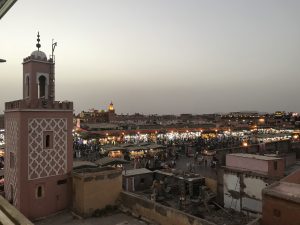
A view of Jemaa el-Fna from one of the terraces overlooking it.
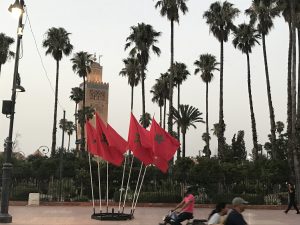
Last weekend’s visit to Marrakesh was different from all the other weekend excursions to other cities in the past four weeks. Due the very high daytime temperatures, people are more active at night thus it was fascinating to see how full the Jemma El-Fnna, the Marrakesh square and marketplace, would get at night even past midnight with people buying and selling various commodities or watching different musical, acrobatic or snake charming performances.
The most important part of the trip was the visit to the Lessane Arabi Language Center where we had a talk-cum-discussion with representatives from different NGOs working to improve Morocco in different sectors. The presenters were the director of the language center, President of the High Atlas Foundation, a representative from Les enfants de l’Atlas orphanage and another from Help Adopt Cats and Dogs in Morocco.
What was interesting to notice in this group was that they all were standing up for issues that aren’t cared much about by many Moroccans and as someone who deeply cares about social issues, this was particularly important to me. There are many stray cats and dogs in Morocco that don’t get proper care, get sick or even get killed so starting and running an animal orphanage like Milena and her friends did is something Morocco needs. But the most impressive of these three groups, in my opinion, was the orphanage because it’s a special one! Les enfants de l’Atlas is a home for over 100 children who were born out of marriage. Morocco is a Muslim country and having children before marriage is something that’s not taken lightly. The Quran condemns sex before marriage as stated in Surah Al-Israa, verse 32 : “and come not near to the unlawful sexual intercourse. Verily, it is a transgression of Allah’s limits, and an evil way.” This coupled with traditions, leads to rejection and demonization of ‘illegitimate’ children by the community.
While there’s no official punishment by the laws of the country, there’s a lot of stigma attached to this as such children are not accepted into the family and are not even entitled to some of the services babies born within marriage are, such as immunization. It’s the women who suffer a great deal in this situation because no one would even care to know who the father is as long as they weren’t married. Thus, the mother has only two options: either leave her family and look after the baby elsewhere or dump it in front of a public office or a mosque. Considering that most of these mothers don’t even have jobs, they have no option but to abandon their babies. I was reading the orphanage’s magazine where they featured a woman who had such a baby and couldn’t even get her baby immunized because to do so, the officials required a birth certificate which is not issued for such children, to begin with. The mother says she was required to pay 650 dirham (about 65 dollars/6500 Ksh) to get the certificate from the hospital, an amount she couldn’t raise, and was lucky to get help from a well wisher. This is just one of the many sad stories of these struggling single mothers. According to the ministry of Social Affairs, about 25 babies are found abandoned every day, adding up to a total of about 10,000 babies a year!
I was really impressed with the project, so together with other six friends from the program, we visited the children the following day and oh man, was it nice spending time with these cute angels. Just to give a background information, the center was founded by a Huber Hansjörg, a former Swiss insurance expert who put a big portion of his wealth into it. The orphanage now has 10 houses- each housing about 10 children- a hospital, school, amphitheater and a mosque.One house is for children with disabilities and have extra services and more care- even a therapist who ensures that all their needs are met. The children receive lessons in Arabic and French, as well as classes in dance, music and agriculture. The extensive land forms a village of its own called:

The center has employees who stay with the children all day and night, taking care of the kids like their own and in the summer volunteers usually come into the country to help out. It was a bit sad to notice that the only male figure is the founder which again points to the society’s lack of support for single mothers. Regardless, I was so happy to see the kids taken good care of and despite society’s dislike for them, have found a heaven in Les enfants de l’Atlas, away from the hatred of the society!
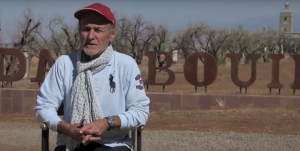
Huber Hansjörg
After visiting Marrakech, it is easy to understand why this city is Morocco’s touristic capital. The name itself is filled with mystery and intrigue. Marrakech has a little bit of everything. The winding markets are reminiscent of Fez, the city is within day-or-weekend-trip-distance of the Sahara Desert and many of Morocco’s most famous cities, and its grand square, like the square we visited in Meknes, teems with life and excitement. Its palaces and tombs offer a historical perspective to the city, and the dusty pink buildings and overwhelming aromas of spice seemingly confirm what many might imagine ~~Morocco~~ to look like.
We spent the first two days absorbing the scenery and scents and wandering around without too many objectives. Our third day in Marrakech, we had a free morning before the bus departed in the afternoon, so a few of us decided to visit the Bahia Palace and Saadian Tombs. Our group was supposed to visit the palace when we had arrived on Friday, but due to some travel time miscalculations, we didn’t make it before closing.
The Saadian Tombs date back to the late 1500s and were discovered and renovated in the 1900s. We were interested to learn that while royalty was buried inside, the palace servants were also buried in the area, just outside of the building. Bahia palace, only a few minutes’ walk away, was built in the 1800s and features staples of Moroccan handiwork and architecture. These sites were a beautiful insight into different stages of Moroccan history, as well another glimpse at the common elements we’ve seen in many buildings.
Before coming to Morocco, Bailey and I spent a week in Spain where we visited the Alhambra in Granada and the Alcazar of Sevilla. Both the palace and the tombs were reminiscent of these historical sites. While we’ve been in Morocco, it’s been so interesting for us to see how many places we’ve visited remind us of the historical sites we visited in Spain. Of course, the historical and architectural link behind the similar plaster, zellij tiling, gardens, arches, doors, woodwork, and other elements between the two places is clear, but beyond a simply logistical perspective, it was interesting to think about why these sites might be more famous or draw more crowds in Spain than in Morocco, despite their equivalence in splendor. I know that I would have been much more struck by the beauty of the palace if I hadn’t seen similar architecture so recently in other cities in Morocco and in Spain.
Like the palace, Marrakech itself has a little bit of all the wonderful things that I’ve seen so far in Morocco. So much so that a few of us in the group commented that many of the sites we saw in Marrakech now felt familiar after five weeks in Morocco, and that if we had visited Marrakech as our first stop, we would have been far more surprised by its beauty and intrigue. In some ways I am sad that I’ve become less bewildered by Morocco’s all around beauty and allure, but in other ways I am so glad to have spent so much time here that seeing its beautiful natural and city settings has become a normal part of my daily life here.
 A visit to Bahia Palace  A room at the Saadian Tombs
Marrakesh is a city that is brimming with life. The souks and streets are crowded and noisy, with bikes and motorcycles weaving through at breakneck speeds. In Place Jemaa el-Fna, the main square, acrobats, dancers, musicians, and singers performed for huge crowds, while vendors peddled their wares from all sides. However, during my time in Marrakesh, I found myself considering the animal lives around me. As in all of the other Moroccan cities I had visited, skinny cats and kittens swarmed the streets, begging for food scraps and sleeping in gutters. Stray dogs, too, roamed the streets looking in need of a good meal and a trip to the vet. Street merchants displayed cages packed with chameleons and turtles for sale—either for tourists or, as I read in A House in Fez, ritual sacrifices. Horse-drawn carriages filled the streets but many of the horses looked in bad shape—protruding ribs and hip bones, matted coats, overgrown hooves. I saw several carriage horses stumble to their knees over the course of the weekend, and, as I watched a horse be fed and shod while hitched to a carriage, wondered if they ever got a real break from their jobs. Alongside the human performers in Place Jemaa el-Fna, cobras waited in baskets to be summoned by snake charmers and monkeys were led from tourist to tourist by the chains looped around their necks. I know that there are many, many, problems facing the world and Morocco, but I couldn’t help but feel sorry for these animals—especially those who were being used for monetary gain. I wished there was another way Moroccan people could earn a livelihood, but I didn’t know what that might be or how I could have any impact.
On Sunday, our group met with several representatives from NGOs and volunteer organizations based in Morocco. One woman was from a group called “Help Adopt Cats and Dogs from Morocco.” Essentially an animal shelter, she talked about her work taking in sickly dogs and cats off the street, nursing them back to health, and then finding them forever homes. She also discussed HACDFM’s efforts to implement Trap-Neuter-Return programs in major cities in Morocco to try to curb the growth of cat and dog populations. She herself admitted that there were other problems facing Morocco, and that the organization couldn’t help every animal, but she felt proud of her work and the fact that she had made a difference in the lives of many cats and dogs.
Her talk inspired me for several reasons. First of all, I was glad that I wasn’t the only one who was troubled by the state of being of animals in Morocco. It was heartening to know that there were indeed organized groups focused on animal welfare and activism. Secondly, I admired her commitment to her cause: even though others might say that there are “bigger” problems facing the Morocco, it didn’t dissuade her from fighting for something that she believes in. And, just because she was unable to help every animal in Morocco, does that mean she shouldn’t help any? Over the course of my time in Morocco, we have visited several NGOs and organizations in Morocco with various goals and methods. As we leave each meeting, I find myself asking: Are they doing enough? Are they doing it the right way? Such questions are important, but I feel we must be careful not to be too critical. After all, doing a little good is better than not doing any at all.
 Carriage horses on the streets of Marrakesh.  A chameleon for sale in the souk in Marrakesh.
“You know, she’s something of a legend in this town.” Naoual rose from her perch on the corner of the wooden desk covered in loose papers and an overflowing binder. “To be honest, I’ve never seen her myself,” she conceded, “but some of my friends have.” Others in the room chirped with stories of affirmation, citing occasions of her spotting at a square or somewhere downtown. “She’s brave,” Naoual meditated, looking out the open window in the back of the room, “I know I couldn’t do it. She has to be strong— like a man— if she wants to survive. People will try to take advantage of her because she’s a woman, but she must stand her ground.” I nodded in agreement, remembering my own journey this morning. Like metal ladybugs spitting plumes of exhaust, hundreds of nearly identical little red taxis swarm through the tight and winding roads of Fes. In only one of these cars is a female driver. Her conception instigated a buzz throughout the old imperial city. A woman driving a taxi? Unheard of— and perhaps not even allowed. Why would her husband permit her to take up a job traditionally reserved for men? It was unbecoming of a woman to assume such a position, and perhaps telling of her spouse’s failure. A Fassi taxi driver is acerbic and reckless, coasting in and out of traffic with narcissistic intentions to get wherever he needs to go the fastest. He is sometimes underhanded and always determined to make the most money he possibly can, even if that means cheating his customer. It was hard for the locals to imagine a woman fitting into this picture. But nevertheless, today she drives, a victory for the women of Fes.
Four-hundred kilometers away, the wooden stalls of street merchants begin to clatter forcefully as two motorcycles blaze a trail through the narrow street surrounded by high red walls. The pedestrians jump out of the way, praying they will remain unscathed by the blitzing vehicles. Out of the corner of my eye, I catch the pop of color of a head scarf. “They’re so empowering, the women riders,” Meriam tells me in awe. “I thought about getting a motorcycle of my own, but there’s no way I could have one back in Fes.” The Marrakech medina is made up of equal parts tourists, shopkeepers, and motorcycles. The bikes fly by constantly, leaving a choking black haze in their tracks. They honk madly at foot traffic, annoyed by its mere existence. But the most interesting part about these bands of riders is the inclusion of women in their ranks. Nowhere else has there been an abundance of women driving motorcycles in the country of Morocco. Usually, they are seen driving cars (although still less frequently than men); however, here in Marrakech, women speed by without a single worry other than their urgent destination. Most consider the Red City to be the most open-minded in all of the country, unsurprising due to the number of European tourists and the Western influence over the years. This liberalism has trickled down to the emboldened female riders. However, it was a shock to have these motorcycles allowed in the old medina of Marrakech. Perhaps I was spoiled by the prohibition of vehicles in the Fes medina that I was horrified to find them coming at me left and right in Marrakech. The roads felt too small to accommodate the both of us, and due to the size and speed of the motorcycles, they often won out. I remember walking down a street when a bike ran into the back of my leg.
“Attention!” the rider yelled at me in French, obviously frustrated with the tourists in his city. But his assumption that I should have known he was coming up behind me was absurd. The traffic in the area made it impossible to hear him coming, and I certainly did not grow eyes in the back of my head. Another instance which shocked me was in the heart of the medina. Hundreds of people were moving indiscriminately and a motorcycle ran through the crowd, forcing the people to make way for the entitled driver. It was stunning to me that this could be allowed, or that someone would even think it appropriate to do something like this. It became a delicate question in my mind: How can Moroccans balance the old with the new? While motorcycles are a great convenience and allow women a new opportunity in society, they wreak havoc in the busy and touristy souks. It is an issue whose themes impact the entire country. How can modernity be attained while preserving a historically and culturally important past? The solution is not one which is clear, but like the Fassi taxi driver, the future can hold many unexpected answers.
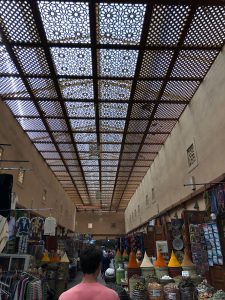 The busy souks of Marrakech 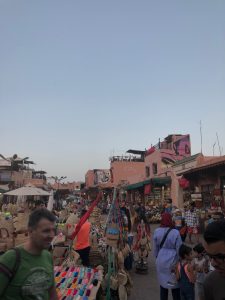
Once the actual capital of Morocco, Marrakech, otherwise known as “The Red City,” is now the tourism capital of Morocco. In 2017, two and a half million people visited the city – a 20% increase from 2016. I immediately knew why Marrakech attracts so many internationals when we exited the bus and made a 3-minute walk through the medina to our riad. We passed by innumerous ‘shops’ in the souk with aromas from their spices, oils, and soaps that wafted throughout the Medina’s streets, beckoning you to turn back and find the source of the smell. Shopkeepers, eager to make a sale, yelled as we walked past, advertising their goods with lines like ‘Good price! Very good deal I make for you. Come see.’ Unrelenting even as I walked away, their calls began to wear on my nerves quickly. Upon later observation, I noticed the shopkeepers only tried their marketing skills on the tourists.
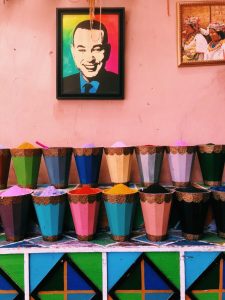 Dyes in the Marrakech souk  The Marrakech Medina Later that night, I found myself in the infamous square, Jemaa el-Fnaa. Cross-dressing belly dancers, snake charmers, and musicians littered the square, drawing a crowd with every incredible performance. It had countless exotic animals chained at the neck and picture ready. Kiosks selling freshly squeezed fruit juice housed young Moroccan men avidly waving at passerby to come and try the juice in hopes they would buy. It seemed to be out of a storybook. Or maybe a never-ending carnival.
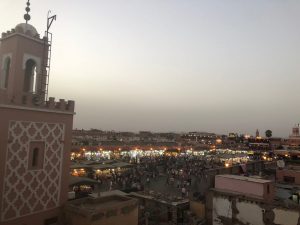 Jamaa el-Fnaa from above at dusk  Marrakech’s streets at night I couldn’t help but wonder how it was feasible for locals to live in Marrakech given the exorbitant prices (compared to other cities in Morocco). Simo, a young Moroccan who showed us around during our time in Marrakech, told me only rich Europeans live in the Ville Nouvelle. He spoke a little about the cost of living in Marrakech, but he was mostly concerned about the lasting cultural influence the Europeans have had and will continue to have in Morocco. With tourism increasing drastically every year in Marrakech and other Moroccan cities, the resulting factors most likely won’t be kind to the local civilians who live in or near the city center. Gentrification is real, and it isn’t usually pretty.
Early Impressions
I first thought about Morocco and Marrakesh when I was 15 years old and ordering lamb at Marrakesh Restaurant in Disney World. I remember a belly-dancer in “exotic” clothes, ornate plasterwork, and goofing off with my friends. It was a tasty dinner, though, in hindsight, the lack of tajine makes me doubt its authenticity.
 Belly Dancer at Disney’s Marrakesh Restaurant 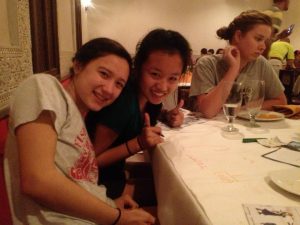 15 Year Old Me at Disney’s Marrakesh Restaurant Four years after this early memory, I felt apathetic towards our upcoming Marrakesh trip. As I shoved some clothes into my backpack last Friday night, I thought I didn’t need a visit to Marrakesh, Morocco’s tourism capital, to round out my cultural education. A week and a half in Rabat’s breezy weather, combined with the beautiful mosques and ancient buildings I have visited in Casablanca and Fez, made me feel very complacent about my Moroccan experience so far.
When we arrived in Marrakesh around midday, it was hot and filled with tourists, as I expected. The dusty-rose color of the buildings was a novelty. I was too dehydrated and sleepy to appreciate much else. Apparently, I was also too tired to process the angry vendor’s words as he told me not to take a picture of his wares.
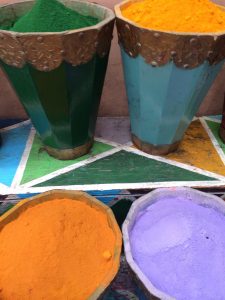 Powder Dyes in the Jewish Quarter On some level, Marrakesh seemed like a caricature of Morocco. While our program made plans for our free time in Marrakesh, we realized that most of our options were things we had already done: hammam, explore a riad, and visit more ruins. After returning to a more hydrated state, however, I saw that I had experienced several new things on this trip.
Three Views in Marrakesh
Our first full day in Marrakesh, we visited a language center. Three non-profit organizations told us about their causes: an alternative orphanage structure for children born out-of-wedlock, animal welfare, and sustainable community development. The first organization helped fund children who are traditionally disadvantaged in Moroccan society. It offered education, arts exposure, and multilingual training. The second organization was very new, and it provided sanctuary to street animals. The final organization had much older roots than the first two. It focused on transforming agriculture through a community-based support system. The more rural organizations were a reminder of how little countryside I had seen.
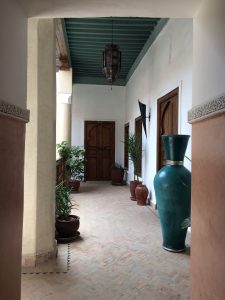 Riad Bayti Later that day, an older English professor approached us after our lunch at the riad and commented that our constant phone usage was a “disease.” He claimed he was curious about why this was. After a short conversation with him, we realized he seemed to be more interested in reprimanding us for our phone usage than actually understanding some of the causes of it. While I agree that my generation uses cell phones as a crutch, he let his 30 minutes of observing our phone usage to inform his entire interpretation of our group as individuals. This was a frustrating, but educational experience.
Our last evening in Marrakesh, we bumped around the souk like slow-moving pinballs. I reflected that many visitors on the crowded street would think of Marrakesh as Morocco’s defining city. It seemed sad to have such a narrow experience with al-Maghreb, but then I realized I had a similar relationship with Morocco. I know little about rural areas, there are still several cities I haven’t seen, and I didn’t explore the cities I lived in as well as I could have.
My brain feels oversaturated with colors and other new sensory input almost every day here. Yet even with all of the fresh perspectives, my memories cannot compare to an entire lifetime of living in Morocco. This limitation reminds me that each brief glimpse shapes the way I think of this country, and I am not exempt from being blind to a large part of Morocco’s identity. Just like I look back at Disney World Morocco and laugh at some of the incongruities now, in the future I might adopt a similar view to my current perceptions here. While I didn’t visit many new monuments in Marrakesh, I certainly learned how important it is to consider perspective. With just a week left here, I realized that my Moroccan experiences are far from complete.
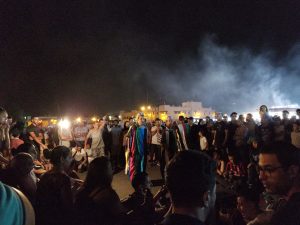
Fun Fact: I can sense auras and essences. I’m sensitive to energies. Also important to know: In my experience, the essence and/or aura of a person or place can change from one day to another: however, this is rare. Most aura’s are consistent.
These kinds of self-proclamations are usually useless and dubbed as “crazy talk,” but please try to keep this context as you read my following thoughts on Marrakech…
Even during the unbearingly hot days, juice vendors, henna tattoo artists, and snake charmers with cobras fill the main square. Hopeful and joyful energies fill the square, a mixture of a reliable rusty red with hints of a harmonious golds and yellows. Marrakech is even more vibrant when the sun sets.
Never have I seen such a drastic change in aura, especially one so consistent as Marrakech’s daily one.
As soon as the sun sets, when the city cools down enough for families to leave the shelter their homes provide from the unforgiving sun, an energy fills the city like no other. There are the same rusty red and golds, but there are also mysterious blues and warm purples, all blending together as if part of a sunrise. All after sunset.
Herds of Berber musicians beating their drums and vocalizing, the crowds swaying in enchantment. Acrobats performing acts that has one questioning the human anatomy. Marrakech is unreal, and simultaneously it is the only reality surrounding you.
The fluidity of the surroundings can be off-putting. At the heart of this reality, there are the blues and purples, and as one nears the edges, golds and red blend into the blues and purples. It’s an inverted color explosion
Ana and I were guided by our friend after most of our group had gone back to our Riad. We walked aimlessly, Ana and I awestruck by the vibrance Marrakech exerted in the night.
We ended up walking four miles that night, and never did we feel tired. Good energies never let you feel tired.
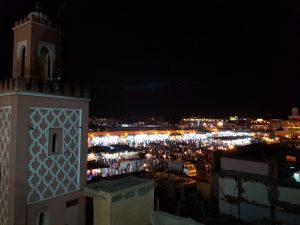
What comes to mind when one thinks of Dubai, or perhaps Qatar? Skyscrapers and luxury vehicles are what comes to my mind. In her book Tribal Modern, Miriam Cooke offers an inside look into the Gulf States and how its citizens’ unspeakable wealth from oil drilling is transforming the national identities of their members, for better and for worse. The combination of tribal and modernity in the U.A.E. renders a unique political, religious, and social climate unseen in any other part of the Arab World. Tribal Modernexcellently enumerates the ways in which the mix between tribal and modern have affected the way Gulf nation-states express or brand themselves while challenging the strict tribal/modern dichotomy; however, Cooke gets lost in her narrative of the barzakh towards the end, straying from the main idea of Tribal Modern.
Tribal Modern begins with a brief history of tribes in the Arab Gulf and how they’ve evolved via modernization. Cooke defines a liminal space she calls the barzakh,rendered by a mixing of the tribal and the modern, where neither element overpowers the other and it remains a heterogeneous mixture. She provides multiple examples of this barzakh such as heritage sports, architecture, pop culture, television/movies, and art. Conclusively, Cooke claims that the modern identity of the Gulf States gives way to “national distinctiveness” rather than indicating a loss of culture or heritage (171).
When discussing how the nation-states are defining themselves in the 21stcentury, Cooke does a thorough job of including several dimensions of society in which these identities are performed. She discusses the way citizens dress to distinguish themselves from non-citizens – an important defining element of one’s individual identity. She states, “…Gulf Arabs perform nationality and privilege through tribal dress” (125). The way U.A.E. citizens present themselves, even when traveling, sends a powerful message; their wardrobe is a modern simulacrum of the traditional tribal dress.
Another type of performance making appearances on the global stage is reenactments of ancestral professions and heritage sports which were not nearly as glorious as they are made out to be. Camel racing, pearl diving, and falconry are just a few examples of traditional activities that used to serve as support for a tribe’s livelihood but have become spectacles for others’ entertainment. Cooke points out that the barzakh produced by the mixing of these heritage sports and the modern world’s orientalist idealization results in “…a new activity […] unrecognizable to the pre-oil Gulf Arab…” (106). She does a thorough job of explaining why this image is projected, stating,” Nostalgia is a kind of currency. […] It is a significant component in invoking collective historical memory” (112). While this mindset may not be conducive historically accurate representations of Gulf Arabs’ culture, it is important to conceptualize the national brands.
She also provides examples of infrastructure and exhibits in Qatar and Dubai that allow these two nation-states to shape how the world perceives them. Norman Foster’s Zayed National Museum in Abu Dhabi and Jean Nouvel’s Qatar National Museum design plans are illustrations of a combination of expensive, modern materials and symbols of ancient tribal culture. Cooke writes, “The museum[s] will elaborate a distinctive identity permeated with the barzakh motif: it is neither Gulf nor Western, tribal nor modern, and yet both and, above all, something else” (82). The reconstructed Suq Waqif designed by Muhammad ‘Ali provides a place in which the local population of Doha can retreat and tourists can see an “authentic souk.” ‘Ali painstakingly combed through old records, documents, and pictures to create one of the most “authentic-inauthentic binary” the Gulf States have seen yet (95). Authentic-inauthenticity is an important theme throughout Tribal Modern which supports the prevalence of the tribal/modern barzakh.
However, towards the end of the book, Cooke starts to wander a bit from her original narrative. She discusses the gender barzakh in the Arab Gulf, but fails to tie it back to the main idea, letting the readers become lost for a while before she pulls things together in Tribal Modern’sconclusion. Boyahs, or cross-dressing females, wear the national brand in an unconventional way to create shock and make a statement about the Arab Gulf’s strict gender binary. Cooke writes, “Living between socially constructed subjectivities, boyahs inhabit a gender barzakh that connects and disconnects specific identities, whether female-feminine or male-masculine identities” (151). She makes a very good point, but I fail to see the relevance. While boyahs are attempting to break the traditional mold, this subject is more applicable to a discussion about the effects of modernization on the Gulf States without emphasis on the tribal remnants.
While Tribal Modern communicates the ways in which the national brand is comprised of a barzakh of many things, be it art, architecture, sports, clothes, or movies, Cooke fails to tie her discussion of changing gender roles and cross-dressers back to the main theme of the book. I would recommend this book for those who want a brief overview of how the United Arab Emirates are making waves in the 21stcentury, but desire a lighter and engaging read. While the book is not up to date, it provides an excellent foundation for understanding the implications of wealth in the Gulf States up until 2012. Additionally, it is a wonderful way to rid one’s self of preconceived notions about the Gulf States. Tribal Modern is an excellent introduction to a wide range of readers – not just students and scholars – who wish to know about modernity within the Arab Gulf.
Tribal Modern Book Review:
When Miriam Cooke visited Dubai in the 1970’s, it was a “dusty town” whose only tourist attraction was an old Russian hospital (2). Now, Dubai’s tourism website features good-looking twentysomethings sharing adventures and shopping among aspirational architecture. Dubai offers everything from a zipline through its urban landscape to snowboarding in its mall. For enough money, one can even go pearl-diving with “Major Ali,” a third generation pearl diver (https://www.visitdubai.com/en/pois/pearl-diving-with-major-ali). Almost fifty years later, Dubai seems like a revamped city, yet it still offers some of the defining cultural elements of its past. Cooke refers to this “undiluted convergence” of tradition and modernity as barzakh. This cultural analysis uses current movements and ideas to demonstrate how the tribal and the modern can coexist. While some people may question how “real people can live in such unreal places,” Cooke argues that the tribal identities of the Arab World are crucial components of the modern identity. Through this approach, Cooke’s book Tribal Modern successfully provides a comprehensive examination of Arab Gulf Civilization that explains, and provides examples of, the paradox of barzakh.
Tribal Modern uses an analysis of the history, institutions, and cultural phenomena in the Arab Gulf to highlight the “undiluted convergence” of barzakh. Throughout the arid peninsula’s past, interstate trade has facilitated cultural, ethnic, and product diffusion. However, the Arab Gulf’s response to an influx of foreigners is to ignore this component of history and opt for a reinvented history of pure tribes. As a result, this tribal affiliation plays an important role in both claiming rights and shaping national identity in the Arab World, as well as excluding foreigners from Arab spaces and preventing non-Arab groups to gain power in the region. Tribal lineage is even more powerful because it now determines race, which determines socioeconomic class. The barzakh of tribal powers influences both the design of architecture ranging from vernacular to the national museums. According to Cooke, new spaces are a platform to share an “old” history that has been rewritten to remove the hardships faced by Arabs of the past and celebrate the rest of the culture. The revival of traditional dress and Bedouin poetry also contribute to this rebranding. While some women easily embrace a the barzakh lifestyle, others turn to literature or experience backlash to the changing gender roles of society. Cooke concludes that this new cultural approach has allowed the Arab Gulf states to become economic forces by exporting their culture, not just their oil, and investing in others’ states as well.
Cooke makes Arab culture more accessible to Western readers by providing first-hand accounts that explain non-Western perspectives. Cooke interviews students and workers (16, 32), but she also analyzes the cultural products of the Arab Gulf for the reader. In one chapter, she focuses on women in the Middle East. While they are often depicted as voiceless members of society, Cooke’s inclusion of women’s writing not only disproves this stereotype but also introduces a literary motif unique to the Arab World. Some women embrace barzakh, whereas others find the new walls of society restrictive and counter to their daily lives (151). This variety of feeling demonstrates the complexities of society in the Arab Gulf. While some people symbolize the coexistence of tribal and modern, others embody the belief that tribal and modern exist as a binary. Women creators connect the cold to “the refrigerator of my soul,” a family’s abandonment of their matriarch, and art through pieces like “Anxiety of Place” (155 – 158). This example provides proof of Cooke’s eye for unique cultural traits of the Arab Gulf. Furthermore, its placement at the end of the book ensures that readers understand the Middle East within the full context of threats from foreigners and the changes that have accompanied the oil boom. By focusing on a direct translation of Arabs’ perspectives, Cooke stays true to the zeitgeist of the Arab Gulf that still connects to Western readers.
Cooke also magnifies Arab culture by examining symbols of national identity and challenging traditional understandings of authenticity. This analysis furthers her identification of barzakh in the Arab Gulf. Pre-oil, pearl diving was an important, but brutal, component of the pre-oil economy; now soap operas and other popular culture components like soap operas romanticize it (107). Like the erasure of the heterogeneous history of the Arab Gulf, pearl-diving has been rewritten to match a more sterile, modern view. Introducing this element of history demonstrates that what the Arab Gulf advertises as “authenticity” has much more complex roots. Removing the layers of history makeup give the readers themselves access to a more authentic understanding of the Middle East. Camel racing has been similarly romanticized, and images of present-day races seem to cater to the Orientalist images of the 1800’s (116). The tribes have essentially capitalized on their past and rebuilt it to match the perception of their fascinating, but not challenging, history. Through camel-racing, Cooke demonstrates the intertwined nature of the Western world’s relationship to the Arab Gulf. Over time, they have both sampled each other’s cultures, and in some cases, the Arab Gulf has even mimicked the foreign influences it now excludes. In response to these phenomena, Cooke elegantly comments that “in the excitement of reenactment, the brutality of the past is forgotten, or rather, it has been deliberately erased” (107). With these two examples, Cooke demonstrates how the climate of the Arab Gulf can facilitate the barzakh.
Cooke continues to transform the barzakh from an abstract concept to a concrete, defining aspect of society through traditional clothing. When the author analyzes the traditional dress Arab clothing, she comments that “local dress signals not only the nationality but also the privileged status of Gulf and Peninsula Arabs” (124). While men in long white clothing fill Western coverage of the Middle East, but Cooke introduces this additional component of power through traditional costume. This inclusion is yet another showcase of the present showcasing what was “old,” even though the traditional costume was not a feasible daily costume in pre-oil days. Even more interesting, her interaction with an Emirati student leads to the quote that “restricting native dress to Gulf Arabs is a survival mechanism, in countries where the local population is the minority” (125). Whereas in the past, the tribal system acknowledged heterogeneity, the present society relies on a “pure” line to ensure superiority in a majority foreign state. The tribal has become more related to modernity, as it is more common to wear traditional garb now than it ever used to be. Bedouin poetry has also been revived, and “the words [millenials’] grandparents used now pepper the language of the Million’s Poet aspirants.” The poetry and language of the past exist in a sensationalized, widely broadcasted manner. Without the barzakh concept Cooke proposes, these ideas seem irreconcilable. Cooke shows that in the intersection of old and new, the traditional inspires the creation of new and ensures that the original forms were preserved.
Cooke’s analysis falters occasionally when she discusses art and poetry. At times, her explanations are so literal that the meaning remains unclear or becomes repetitive. In a poem by Soad Al Kuwari, the poet remarks that “the desert is a fox/dressed like a woman.” Cooke unhelpfully explains that “they are foxes dressed like women” (164). While this happens several times, the book’s quality insights on the evolution of the Arab Gulf prevent this writing from becoming dense and dry. Cooke’s failures are small when compared to the extensive, yet concise research on the Arab Gulf.
Tribal Modern is an enjoyable, educational read. Cooke elevates the academic argument above figures to create a cohesive argument about culture in the Arab Gulf. Her people-oriented analysis gains even more meaning when considered in the historical and social contexts she provides. The accessibility of her argument draws from the unique aspects of Arab culture that she highlights for the reader. As a result, it is a successful, engaging introduction to some of the more opaque regions of the Middle East. Novice students of Arab Gulf politics may have trouble verifying Cooke’s claims, but her numerous resources indicate a meticulous cultural study.
In Tribal Modern: Branding New Nations in the Arab Gulf, Miriam Cooke analyzes the dynamic development of tribes and their traditions in Gulf states whose societies have experienced unprecedentedly rapid modernization in the last thirty years. Cooke utilizes her own experience from traveling in the region, interviews with common Gulf citizens, and artistic literature to formulate the idea that tribal traditions and the Gulf’s rapid modernization are inexplicably tied to one another. Throughout her work, Cooke brings up different examples that argue against the common narrative of Gulf States among analytical thinkers. Cook argues that tribal traditions and structures that have existed for thousands of years are even more present in these new modern states than ever before, but that they have just evolved into deeper, more class-based characteristics that dictate the average citizen’s way of life in these Gulf States. Through a delicately written argument that uses case studies of individual Gulf States like Qatar, Kuwait, Bahrain, and the United Arab Emirates, Cooke successfully describes the nature of these societies, tracing the emergence of a national brand that emphasizes the combination of tribal and modern identities and cultures.
To successfully develop and support her argument, Cooke maintains a common theme throughout her case studies of each individual Gulf State she investigates. First, Cooke describes the tribal as the traditional values and societal systems that have been a center of life for people living in the Arab Gulf for thousands of years. Then, Cooke differentiates the modern as being the newly expressed ideas, like nationalism, borders, and globalization, that have recently been created due to the Gulf’s emergence into the international stage. Cooke routinely applies the term barzakh to denote the relationship between the tribal and modern in these societies. Cooke describes barzakh as “a Qur’anic term that variously designates the metaphysical space between life and the hereafter and also the physical space between sweet and salt waters,” (Cooke, 71). Thus, she uses this ancient Islamic term to symbolize the delicate relationship that exists between the tribal and the modern.
Cooke’s usage of barzakh is apparent throughout the examples she brings up to explain her new narrative. When describing the different national museums that have recently been created in Qatar and Abu Dhabi, Cooke’s reasoning for enlisting the term barzakh becomes apparent. Each national museum, designed by different architects from all over the world, all possess similar qualities. They attempt to pay homage to ancient traditional features of their nation-state, while at the same time emphasizing the importance of their country’s recent modernization and the promising future each of these states has. For example, Cooke writes of Jean Nouvel’s design for Qatar’s national museum “[her] project dives deep into the desert environment of the Bedouin and weaves it into the hypermodern of the twenty-first century Gulf,” (Cooke, 97). Thus, the combination of tribal and modern identities can be seen in the Gulf States’ very architecture, where artists work to showcase this regions deep history and mysterious traditions while also emphasizing their transition into the modern world. The most important element of these societies that Cooke’s description of the museums highlights is the emphasis on representing the past as well as the present. This feature shows that the tribal is not forgotten, or “primitive” like other academics have suggested, but it is rather a complimentary feature that cooperates with and diversifies the Gulf States’ modernization.
Cooke’s argument, that the tribal is an essential feature of the modern Gulf identity and culture, is further supported through her research into the importance of individual tribal identities. Through her research, primarily consisting of conducting polls and interviews, Cooke highlighted Gulf citizens’ desire to idealize the status and reputation of their tribes. Even in modern societies, Gulf citizens showed that their loyalty revolved around their individual tribal affiliations first and then to their “national” tribe. Cooke writes, “These transformations of tribe into race and then class – especially the urban, cosmopolitan class – produce the privileged national citizen,” (Cooke, 63). However, this process inadvertently created unique national identities that emphasized the importance of the tribe in national society. Cooke writes “This process reveals the interdependence of the tribal and the modern, the building blocks for a new brand that the Arab Gulf states are cultivating in order to broadcast power abroad and retain privilege at home,” (Cooke, 63). Thus, old tribal characteristics and traditions are increasingly important in these hypermodern Gulf States.
Through a sheer volume of research, Cooke successfully convinces the reader that the tribal is a central component of these Gulf societies. Cooke’s argument is especially convincing due to the variety of examples she utilizes to support her argument. Whether she discussed architecture, classist identities, or the building of a national brand, Cooke was able to identity the tribal characteristics still essential to the culture of each Gulf State’s modern society.
Accordingly, Cooke seamlessly blended Qur’anic verse and Arabic literature to successfully support her argument. In a style that payed homage to these mystical poems and verses, Cooke herself writes “I have used the words of poets and writers to anchor my analysis of the tribal modern. Creative writers and artists are always ahead of trends, able to see beyond the confusion reigning during times of change,” (Cooke, 164). This delicate style, while risky, worked beautifully to, as Cooke said herself, anchor her analysis with concrete evidence.
Overall, Cooke’s Tribal Modern was an intricately designed book that served to engage the reader throughout the novel. By providing challenging concepts and simplifying them through the explanation of different evidence in Gulf State societies, Cooke succeeded in writing an academic and educational novel that was an enjoyable read. I would recommend this book to any avid reader who enjoys books that challenge the narrative, as, throughout the book, Cooke dutifully fights to debunk the myth that the tribal is “primitive”, a fight which I believe she wins convincingly.
The 1970s introduced a new of era of wealth within countries like Kuwait, Qatar, and the UAE, propelling their economies towards growth and societies towards modernity. Among these states, previously existing tribes had to make a decision as state borders hardened, either become a citizen or maintain their tribal (yet stateless) identities. In Miriam Cooke’s Tribal Modern, Cooke evaluates the transformation of societal perception regarding tribal identity. Within Cooke’s work, however, there is an implied dissatisfaction towards the rebranding of cultural symbols, thus taking an approach emphasizing the fading permeance of their original meaning. In this process, Cooke argues the “clashing” of recent modernity and the imagery of antiquity surrounding tribal affiliation creates an effect of class distinction/separation, state promotion of a cultural brand, and the emergence of the barzakh.
Cooke begins by indicating the growing immigrant population within petro-states is largely due to an increasing export of lower-skilled jobs (Cooke 14). As immigrants began to rival the number of citizens, Cooke states that tribal affiliations and traditional dress became indicators of social and economic class (126). With pathways to citizenship being exclusive to descendants of the “original” ancestors of these petro-states, immigrants have no rights nor ability to move up the social or economic strata (22-24). Governments enforce a distribution of privilege to a selective few, and by doing so influence the continuation of tribal significance. This phenomenon intensifies as governments prepare for post oil-based economies where tourism – and thus museums/historically significant projects – becomes a method of exporting a state’s distinct “tribal modern” culture. This particular intersection where the tribal and modern interact without either assimilating into the other is the barzakh.
Particularly, Cooke’s extensive research into the various modes of influences used to constructed an assessment of the social sphere is admirable. Ranging from the collection of anonymous surveys, to forms of art and literary works, to an assessment of economic profitability from promoting a cultural brand, Cooke is thorough in her collection of evidence. For this reason, one is able to follow her argument about the distinct relationship of the tribal modern. In fact, by providing additional historical contexts with accompanying analyses of their impact on petro-states, your historical knowledge doesn’t need to be expensive to follow her argument.
In spite of Cooke’s sound argument for the unique interdependence of traditional tribal symbols and current social, civil, and economic spheres of wealthy petro-states, she continuously projects a dissatisfied outlook regarding the barzakh. This is understandable, as Cooke states the distortion of older practices has created an idealized national identity where only the desirable aspects survive. “In the excitement of reenactment, the brutality of the past is forgotten, or, rather, it has been deliberately erased” (Cooke 107). Many cultures have been systematically destroyed through colonialism, the standardization of languages for communication, and oppression, but the symbol of the tribe has demonstrated versatility. The regulation of national identity by the government has created a thriving contemporary product, thereby proving that locals can “embrace” traditional values and the modern world (119). Her criticisms of Qatar’s National Museum and similar projects indicate that these shouldn’t be considered barzakh, but instead a fictional recreation of culture (79; 83). Projects like these don’t have preceding permanence in society, however, they are in the process of becoming scions of cultural identity and therefore are not fiction.
Overall, Tribal Modern is a well-developed and expertly researched work displaying a relationship that exists both in theory and realty within its corresponding regional location. Cooke was able to employ a detachment from Western thought which brings us closer to accuracy when observing similar relationships. Regardless of criticisms, her work provides a great example of how one should collect and apply evidence, especially so when applied to a region where accustomed thought processes aren’t as relevant.
|
|




















